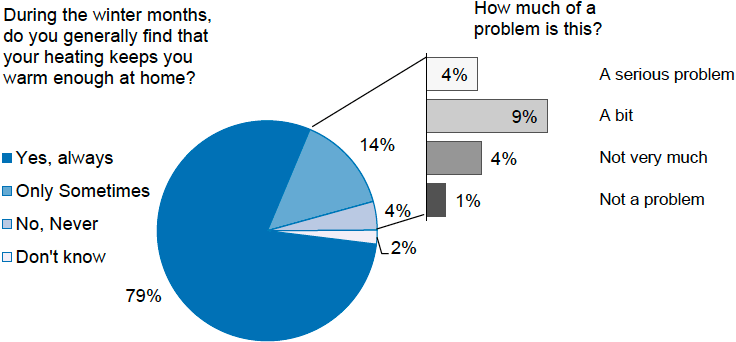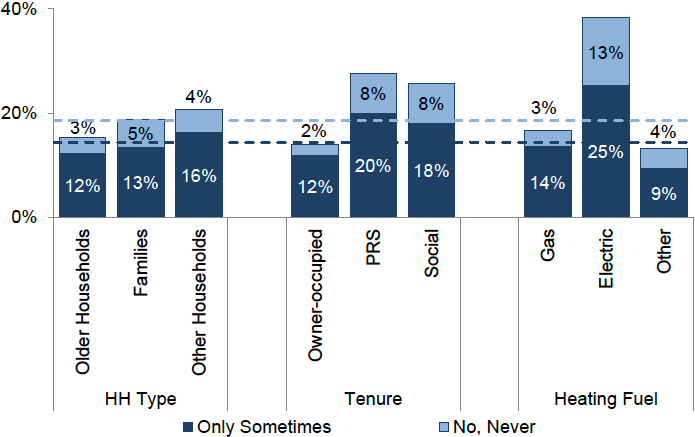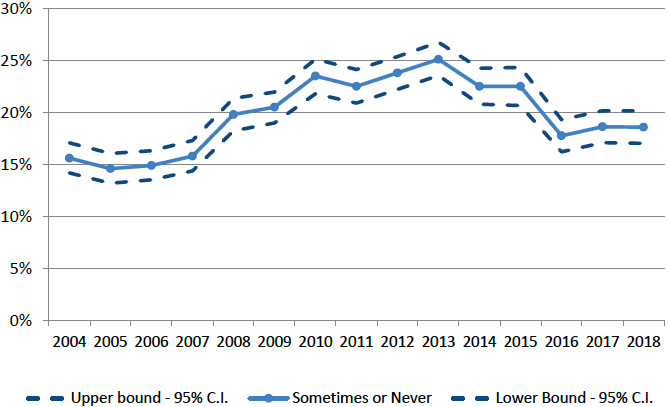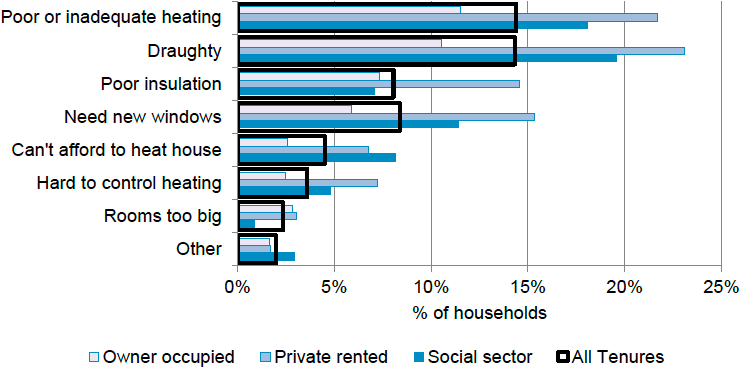Scottish house condition survey: 2018 key findings
Figures from the 2018 survey, including updated fuel poverty rates, energy efficiency ratings, the condition of housing and the Scottish Housing Quality Standard.
This document is part of a collection
5 Energy Perceptions
Key Points
- Nearly a fifth of households find that their heating keeps them warm in winter only sometimes (14%) or never (4%). This is similar to 2017 rates.
- 5% of all households report that their homes were difficult to heat because they cannot afford to heat them, which is similar to the level in 2017.
- Fuel poor households and extreme fuel poor households are more likely to have difficulties staying warm in winter and to report affordability problems; 29% of fuel poor and 32% of extreme fuel poor say that their heating keeps them warm in winter “only sometimes” or “never”, compared to 15% of all other households. 8% of fuel poor and 11% of extreme fuel poor households report that they cannot afford to heat their home, higher than the 3% of non-fuel poor households.
- The extent to which home energy use is monitored by householders has increased since last year with 58% stating they monitor their energy use “very” or “fairly closely” compared to 54% in 2017. 28% of households report owning an energy monitoring device – a 9 percentage point increase on the previous year.
- Fuel poor and extreme fuel poor households are more likely to monitor their energy use than other households (62% and 65% respectively compared to 57% for non-fuel poor households) but they are less likely to own a monitoring device (23% for both compared to 29% for non-fuel poor households).
5.1 Heating Satisfaction
231. Respondents’ views on their ability to keep warm in the winter and why this may be difficult is a useful context for understanding statistics on fuel poverty and energy efficiency in the home.
232. In 2018, 79% of householders reported that they were always able to stay warm at home during the winter (Figure 26), 14% said that their heating keeps them warm only sometimes, and 4% report that their heating systems never keep them warm in winter. These are similar levels to 2017.
233. Of those reporting that their heating system keeps them warm in winter “only sometimes” or “never”, 21% report this to be “a serious problem”, 49% “a bit of a problem”, while 30% said it was “not very much” or “not a problem”. This distribution is similar to the results from the 2017 survey.
234. Of all households, 4% reported their heating not keeping them warm in winter, and this to be “a serious problem”, while 9% said it was “a bit of a problem”, both which are at similar levels to 2017.
Figure 26: Staying Warm in Winter, 2018

Figure 27: “Does Your Heating Keep You Warm Enough in the Winter?” by Household Type, Tenure and Primary Heating Fuel; 2018

Note: Dashed lines represent the Scotland levels shown in Figure 26.
Note: There was one N/A response for Primary Heating Fuel which has been excluded from the table but included in the Scotland statistics.
235. Figure 27 shows respondents’ views on how well their heating systems keep them warm in winter vary depending on household (HH) type, tenure and the primary heating fuel they use.
236. Older households are less likely than other household types to report that their heating system doesn’t always keep them warm in the winter; 15%, compared 21% of other households.
237. Householders with electric heating have a high propensity to report that their heating systems does not keep them warm in the winter (38%).
238. Social and private renters also have increased likelihood to report that their heating does not always keep them warm compared to owner occupiers. For social sector tenants this is in contrast to the relatively better energy efficiency of the dwellings they occupy compared to the housing stock overall (as shown in Table 19).
239. Figure 28 shows how the proportion of householders reporting that their heating does not always keep them warm has changed over time, allowing for the margin of error. Following the significant decrease in 2016, there was not a significant change in the proportion in 2017 or 2018.
Figure 28: “Does Your Heating Keep You Warm Enough in the Winter?”, Proportion ‘Sometimes’ or ‘Never Warm’, 2004-2018

240. The reasons why people find their homes difficult to heat are shown in Figure 29 and Table 41. The most common reasons relate to poor energy performance of the dwellings: poor heating systems and draughts (14% each) followed by insulation and windows (8% each). About 5% of all surveyed householders consider it unaffordable to achieve the indoor temperatures they want. This is higher among private and social renters (7% and 8% respectively) compared to owner occupiers (3%). On the whole private rented and social sector tenants are more likely than owner occupiers to report difficulties. 65% of all interviewed households did not report any problems heating their homes, a lower percentage than in 2017 (68%).
Figure 29: Reasons Heating Home is Difficult by Tenure, 2018

Note: responses have been grouped by theme, as described in section 7.11.5. More than one answer is allowed so the sum of responses can exceed 100%.
Table 41: Reasons Heating Home is Difficult by Tenure, 2018
| Owner occupied | Private rented | Social sector | All Tenures | |
|---|---|---|---|---|
| None reported | 70% | 52% | 58% | 65% |
| Poor or inadequate heating | 12% | 22% | 18% | 14% |
| Draughty | 11% | 23% | 20% | 14% |
| Poor insulation | 7% | 15% | 7% | 8% |
| Need new windows | 6% | 15% | 11% | 8% |
| Can’t afford to heat house | 3% | 7% | 8% | 5% |
| Hard to control heating | 2% | 7% | 5% | 4% |
| Rooms too big | 3% | 3% | 1% | 2% |
| Other | 2% | 2% | 3% | 2% |
| Sample size | 1,937 | 294 | 733 | 2,964 |
Note: Respondents are permitted to select more than one response. For this reason the sum down a column can exceed 100%
241. Table 42 shows how fuel poor and non-fuel poor households compare in their views on winter heating and heating affordability.
242. Fuel poor and extreme fuel poor households are more likely to report that their heating keeps them warm in winter “only sometimes” or “never”, 29% and 32%, respectively, compared to 15% of non-fuel poor households. For 20% of fuel poor households and 24% of extreme fuel poor households this is “a serious” or “a bit of a problem”, higher than 11% for households who are not fuel poor.
Table 42: Staying Warm and Fuel Poverty, 2018
| Not Fuel Poor | Fuel Poor | Extreme Fuel Poor | |||||
|---|---|---|---|---|---|---|---|
| During the winter months, do you generally find that your heating keeps you warm enough at home, or not? | |||||||
| Yes, always | 83% | 68% | 63% | ||||
| Only some of the time | 12% | 21% | 24% | ||||
| No, never | 3% | 8% | 8% | ||||
| Don't know | 2% | 3% | 5% | ||||
| How much of a problem is this, if at all, to you? | |||||||
| A serious problem | 2% | 8% | 9% | ||||
| A bit of a problem | 8% | 12% | 14% | ||||
| Affordability | |||||||
| Cannot afford to heat house | 3% | 8% | 11% | ||||
| Sample size | 2,173 | 732 | 347 | ||||
243. Fuel poor and extreme fuel poor households are also more likely to report affordability problems. When asked about the reasons why they find it difficult to keep their home warm, 8% of fuel poor households and 11% of extreme fuel poor households say “cannot afford to heat my home”, compared to 3% of non-fuel poor households who give this answer.
5.2 Monitoring Energy Use
244. Since 2008 the SHCS has asked respondents to what extent they monitor their energy use and whether or not they have energy monitoring devices.
245. The proportion of households who do not monitor their energy use has fallen from 31% in 2008 to 22% in 2012 and remained around that level (20-22%) until 2017, which saw an increase to 24% (Table 43) from 20% in 2016. In 2018, the proportion of households who do not monitor their energy use fell again to 19%.
246. The proportion of those who report monitoring their energy use “fairly” or “very closely” continues to follow a pattern of improvement. The proportion increased from 44% in 2008 to 54% in 2012 and remained around that level until 2017. In 2018 this increased again to 58%.
Table 43: Extent to which Energy Use is Monitored, 2008, 2011-2018
| Extent Energy Use is Monitored… | Year | ||||||||||
|---|---|---|---|---|---|---|---|---|---|---|---|
| 2018 | 2017 | 2016 | 2015 | 2014 | 2013 | 2012 | 2011 | 2008 | |||
| Very closely | 19% | 17% | 18% | 16% | 16% | 17% | 16% | 14% | 11% | ||
| Fairly closely | 39% | 37% | 38% | 41% | 37% | 38% | 38% | 33% | 33% | ||
| Subtotal: Very or fairly closely | 58% | 54% | 56% | 57% | 54% | 56% | 54% | 47% | 44% | ||
| Not very closely | 22% | 21% | 23% | 22% | 24% | 24% | 24% | 22% | 24% | ||
| Not at all | 19% | 24% | 20% | 22% | 22% | 20% | 22% | 30% | 31% | ||
| Don't know | 1% | 1% | 1% | 0% | 1% | 0% | 0% | 0% | 1% | ||
| Total | 100% | 100% | 100% | 100% | 100% | 100% | 100% | 100% | 100% | ||
| Sample size | 2,964 | 2,529 | 2,441 | 2,492 | 2,682 | 3,442 | 3,428 | 3,949 | 3,762 | ||
247. In 2018 28% of households had energy monitoring devices, as shown in Table 44. This is the third consecutive statistically significant year on year increase and represents a 50% increase in the proportion of households with an energy monitoring device compared to 2017.
Table 44: Households with Energy Use Monitoring Devices, 2008-2018
| % of households | Sample Size | |
|---|---|---|
| 2018 | 28% | 2,964 |
| 2017 | 18% | 2,529 |
| 2016 | 10% | 2,441 |
| 2015 | 8% | 2,492 |
| 2014 | 7% | 2,682 |
| 2013 | 8% | 3,442 |
| 2012 | 8% | 3,428 |
| 2011 | 7% | 3,949 |
| 2010 | 4% | 3,853 |
| 2009 | 2% | 4,153 |
| 2008 | 2% | 3,762 |
248. Table 45 shows that fuel poor and extreme fuel poor households are more likely to monitor their energy use than other households: 62% and 65% report monitoring “very” or “fairly closely” compared to 57% of households who are not fuel poor. However they are less likely to have monitoring devices at home - 23% of both fuel poor and extreme fuel poor households compared to 29% of all other households – despite the overall increase in energy monitoring devices recorded by the survey.
Table 45: Monitoring Energy Use and Fuel Poverty, 2018
| Not Fuel Poor | Fuel Poor | Extreme Fuel Poor | ||||||
|---|---|---|---|---|---|---|---|---|
| To what extent do you monitor your use of energy in your property? | ||||||||
| Very closely | 18% | 22% | 22% | |||||
| Fairly closely | 38% | 40% | 44% | |||||
| Not very closely | 22% | 20% | 19% | |||||
| Not at all | 20% | 17% | 14% | |||||
| Don't know | 1% | 1% | 2% | |||||
| Do you have an energy-use monitoring device in your home? | ||||||||
| Yes | 29% | 23% | 23% | |||||
| Sample Size | 2,173 | 732 | 347 | |||||
Contact
There is a problem
Thanks for your feedback